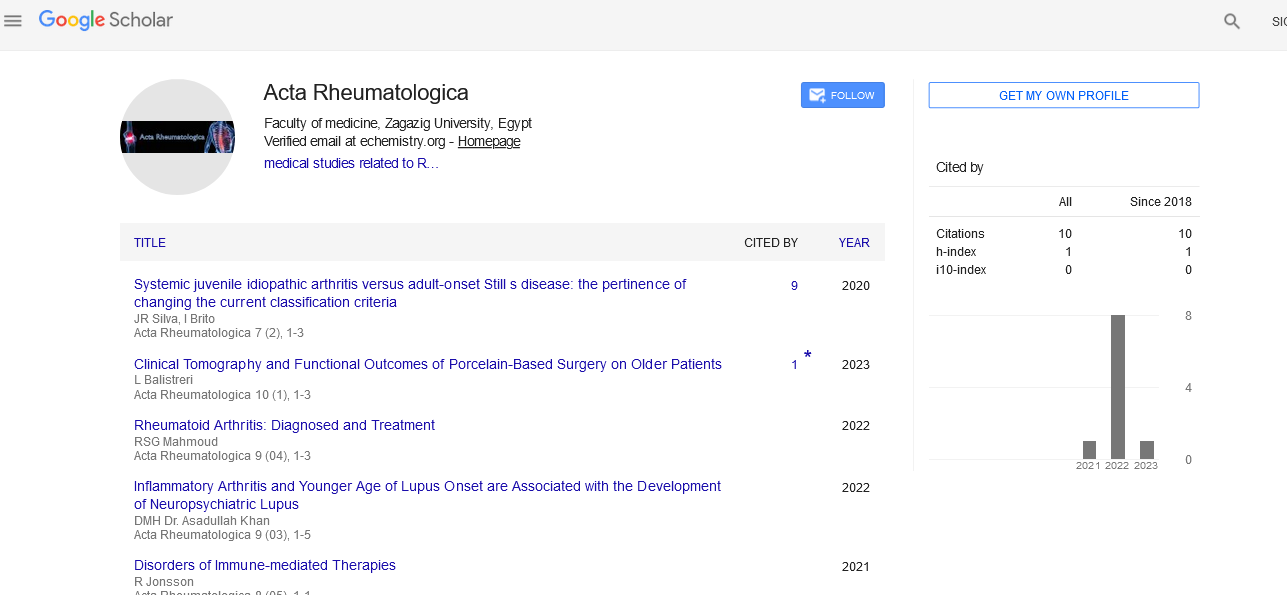Perspective - (2024) Volume 11, Issue 6
Cardiovascular Risks in Patients with Systemic Lupus Erythematosus
Yonathan Aliye Asfaw*
Department of Health Care, Mekelle University, Campus Mekelle, Ethiopia
*Correspondence:
Yonathan Aliye Asfaw, Department of Health Care, Mekelle University, Campus Mekelle,
Ethiopia,
Email:
Received: 19-Nov-2024, Manuscript No. IPAR-24-152465;
Editor assigned: 22-Nov-2024, Pre QC No. IPAR-24-15245 (PQ);
Reviewed: 06-Dec-2024, QC No. IPAR-24-15245;
Revised: 17-Dec-2024, Manuscript No. IPAR-24-15246 (R);
Published:
24-Dec-2024
Introduction
Systemic Lupus Erythematosus (SLE) is a complex autoimmune
disease that affects multiple organ systems, leading to significant
morbidity and mortality. Among the many complications
associated with SLE, Cardiovascular Disease (CVD) has emerged
as a prominent concern. Patients with SLE are at an increased
risk of developing cardiovascular issues, often at a younger age
compared to the general population. Understanding these risks
and their underlying mechanisms is crucial for effective
management and improving patient outcomes.
Understanding systemic lupus erythematosus
SLE primarily affects women, especially those of childbearing
age, and is characterized by a wide range of symptoms, including
fatigue, joint pain, skin rashes, and organ involvement. The exact
cause of SLE remains unknown, but it is thought to result from a
combination of genetic, environmental, and hormonal factors.
The chronic inflammation associated with SLE not only leads to
joint damage but also has far-reaching effects on the
cardiovascular system.
Increased cardiovascular risk in SLE
Research has consistently demonstrated that individuals with
SLE face a higher risk of cardiovascular events such as heart
attacks and strokes. Several studies suggest that SLE patients
may have a cardiovascular risk profile comparable to that of
patients with diabetes or coronary artery disease.
Description
Prevalence of atherosclerosis
Atherosclerosis, the buildup of plaques in the arterial walls, is
a significant contributor to cardiovascular disease. In SLE
patients, early atherosclerosis has been observed even in those
with mild disease and no traditional cardiovascular risk factors.
This phenomenon can be attributed to several factors:
Chronic in lammation: Persistent inflammation is a hallmark
of SLE. Pro-inflammatory cytokines, such as Tumor Necrosis
Factor-alpha (TNF-α) and Interleukin-6 (IL-6), can damage the endothelial cells lining the blood vessels, promoting atherosclerosis.
Autoantibodies: The presence of autoantibodies, particularly
anti-phospholipid antibodies, has been linked to increased
cardiovascular risk. These antibodies can lead to endothelial
dysfunction and thrombus formation.
Hyperlipidemia: Dyslipidemia is common in SLE patients,
characterized by elevated triglycerides and low High-Density
Lipoprotein (HDL) cholesterol levels, which further contribute to
atherosclerotic changes.
Traditional cardiovascular risk factors
While SLE-specific factors play a crucial role in cardiovascular
risk, traditional risk factors such as hypertension, diabetes, and
obesity also significantly affect this population. Unfortunately,
the management of these factors can be complicated by the
disease and its treatment:
Corticosteroids: Many SLE patients require corticosteroids for
disease management, which can lead to weight gain,
hypertension, and dyslipidemia, thereby increasing cardiovascular
risk.
Sedentary lifestyle: Fatigue and joint pain can limit physical
activity in SLE patients, contributing to obesity and associated
cardiovascular risks.
Smoking: Smoking is a well-established risk factor for
cardiovascular disease and is prevalent among certain subsets of
SLE patients. The interaction between smoking and autoimmune
mechanisms may further exacerbate cardiovascular risks.
Heart-related complications in SLE
Beyond atherosclerosis, SLE can lead to a range of cardiovascular
complications, including:
Myocarditis: Inflammation of the heart muscle can occur
in SLE, leading to symptoms such as chest pain, arrhythmias,
and heart failure.
Pericarditis: Inflammation of the pericardium, the protective
sac surrounding the heart, is a common manifestation in SLE
patients. It can lead to chest pain and discomfort and may
require intervention.
Valvular heart disease: SLE patients are at risk for valvular
abnormalities, including Libman-Sacks endocarditis, characterized
by the formation of sterile vegetations on heart valves. This
condition can lead to valve dysfunction and heart failure.
Assessing cardiovascular risk in SLE patients
Given the elevated cardiovascular risk in SLE, regular
assessment and monitoring are vital. Guidelines recommend
that SLE patients undergo:
Cardiovascular risk assessment: This includes evaluating
traditional risk factors (hypertension, cholesterol levels, diabetes)
and specific SLE-related factors (disease activity, presence of
antiphospholipid antibodies).
Screening for atherosclerosis: Non-invasive imaging techniques,
such as carotid ultrasound or coronary artery calcium scoring, can
help assess the presence of early atherosclerotic changes.
Regular cardiac evaluation: Patients should have routine
echocardiograms to monitor for any structural heart changes or
valvular abnormalities.
Management strategies
Managing cardiovascular risks in SLE patients requires a
multifaceted approach:
Optimizing SLE treatment
Effective control of SLE can help reduce cardiovascular risk.
This includes:
Disease-Modifying Antirheumatic Drugs (DMARDs): Medications
such as hydroxychloroquine have been associated with improved
cardiovascular outcomes in SLE patients. Hydroxychloroquine can
help reduce inflammation and has lipid-lowering effects.
Corticosteroid minimization: Where possible, minimizing the
use of corticosteroids can reduce associated cardiovascular risks.
Alternative therapies should be considered.
Addressing traditional risk factors
Lifestyle modifications: Encouraging a heart-healthy lifestyle,
including a balanced diet, regular exercise, and smoking
cessation, is crucial. Diets rich in omega-3 fatty acids, fruits, and
vegetables can help manage inflammation and improve lipid
profiles.
Medication management: Aggressive management of
hypertension, hyperlipidemia, and diabetes is essential. Statins
may be beneficial for controlling cholesterol levels and providing
cardiovascular protection.
Regular monitoring and education
Patient education is vital in empowering individuals to
recognize their cardiovascular risks. Regular follow-up visits
can help monitor disease activity, assess cardiovascular health,
and adjust treatment plans as necessary.
Conclusion
Patients with systemic lupus erythematosus face significant
cardiovascular risks, necessitating a proactive and comprehensive
approach to management. By understanding the interplay
between SLE and cardiovascular disease, healthcare providers
can better educate and support their patients. Optimizing SLE
treatment, addressing traditional cardiovascular risk factors, and
regular monitoring can significantly improve outcomes and
reduce the burden of cardiovascular complications in this
vulnerable population. As research continues to evolve, a deeper
understanding of the mechanisms underlying cardiovascular risks
in SLE will pave the way for more targeted interventions,
ultimately enhancing the quality of life for affected individuals.
Citation: Firew E (2024) The Role of IL-17 Inhibitors in Treating Psoriatic Arthritis. Acta Rheuma Vol:11 No:6
Copyright: Firew E (2024) The Role of IL-17 Inhibitors in Treating Psoriatic Arthritis. Acta Rheuma Vol:11 No:6





